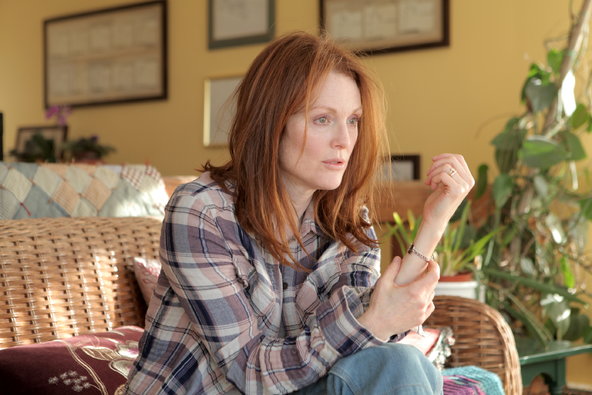
Do casting directors insist on remarkable cheekbones when they’re lining up actors to play characters with dementia?
Think about it: Julie Christie in “Away From Her.” Genevieve Bujold in “Still Mine.” Meryl Streep as Margaret Thatcher.
And here’s one more: Julianne Moore in “Still Alice,” which had brief runs in New York and Los Angeles to qualify for Academy Award nominations and will open nationwide in January.
Dementia seems irresistible to dramatists, with its here-but-not-here characters and bewildered families already grieving for people who haven’t died. Yet these stories remain hard to sell to audiences, along with aging narratives in general. So I suppose we can’t blame producers and directors for populating their films with actors who are, first, beautiful and, second, younger than their characters. People in movies tend to be more beautiful than ordinary folks, period. (At least Emmanuelle Riva, who deserved an Oscar for the unflinching “Amour” — and has the requisite cheekbones — was 85.)
“Still Alice” backs away even further from the usual characterizations, though, by giving its lovely protagonist a fairly rare form of dementia: early-onset Alzheimer’s disease, which afflicts those younger than 65.
Prof. Alice Howland, seen running effortlessly through Riverside Park, is just 50 and enjoying an impressive academic career at Columbia when she starts forgetting words and getting lost in familiar places.
Lisa Genova, the neuroscientist and author of the novel “Still Alice,” has explained her reasons for featuring a younger victim. Alzheimer’s may not be immediately recognized in 80-year-olds, she has pointed out, especially since we expect older people to have memory lapses. A younger intellectual, Ms. Genova said, would notice cognitive lapses at once and be alarmed.
It’s a more dramatic scenario, perhaps, than a plot featuring the elderly; it also allows filmmakers to cast much younger stars.
Fair enough, I suppose. It’s bad form to carp because filmmakers make the movie they want to, not the one you’d prefer. But no more than 5 percent of people with Alzheimer’s have the early-onset variety, and even fewer have the familial form that descends upon Alice Howland.
So as sensitive as “Still Alice” is, with a wonderful a performance at its core, it still feels like we’re afraid to see what dementia most often looks like, who typically gets it and what families really go through. (In movies, moreover, nobody seems worried about the enormous costs of caring for patients.)
The dementia-related movies I found better written, more honest and more moving — “Iris” (starring Judi Dench, an exception to the cheekbones rule), “Away From Her” and “Amour” — were made in Britain, Canada and France, perhaps not coincidentally.
Given our common wish that dementia looked prettier than it generally does, we should applaud the filmmakers, who know something about terrible illness, for tackling “Still Alice” at all.
I do applaud them. Award nominations (Golden Globe, Screen Actors Guild) are already piling up for Ms. Moore. I hope she gets that Oscar nomination, the way Dame Judi and Ms. Christie did in their turns as Alzheimer’s sufferers, the way Bruce Dern did for “Nebraska.” Maybe Ms. Moore will even win.
But I also found myself looking at the screen and thinking, “This is not the way it is.”
An earlier version of this post incorrectly identified Emmanuelle Riva as the winner of an Academy Award for her role in “Amour.” In fact, Jennifer Lawrence won the award for best actress in 2013 for her role in “Silver Linings Playbook.”
